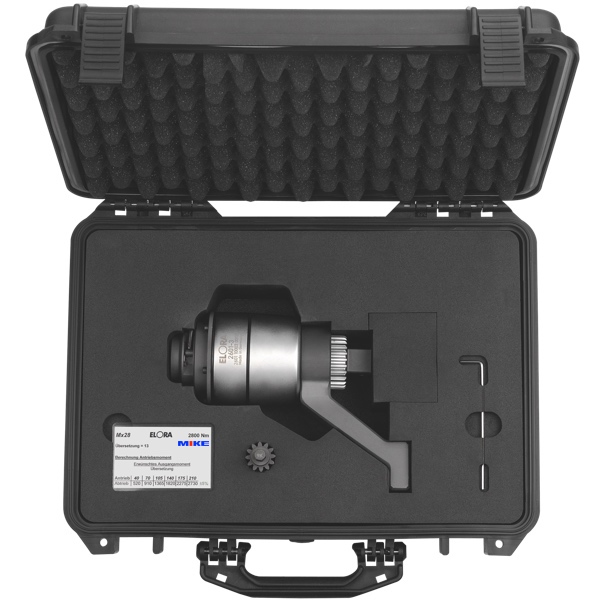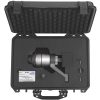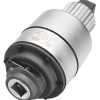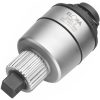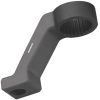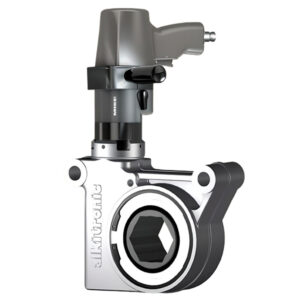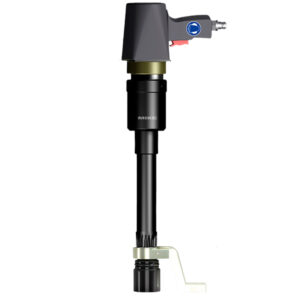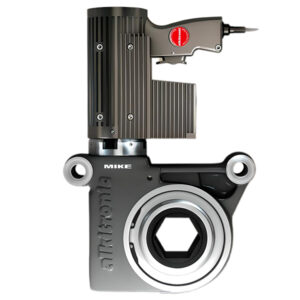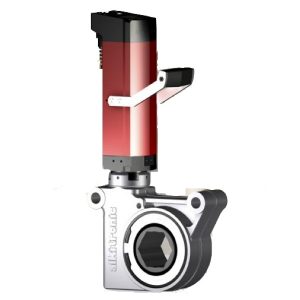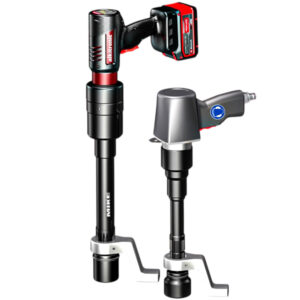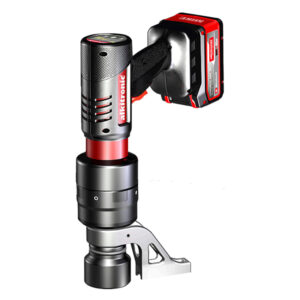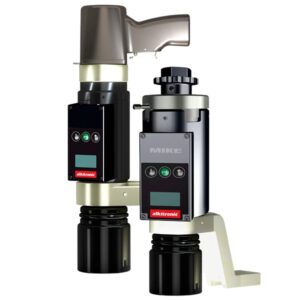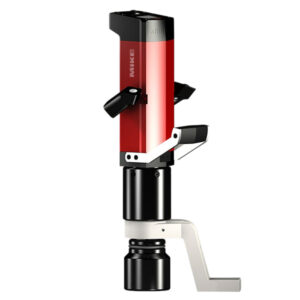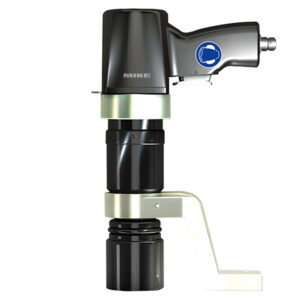Manual torque multiplier ELORA 2601, up to 10000 Nm, compact
SKU: 2601With precision under ±5% tolerance, featuring interchangeable heads, hardened gears, permanent lubrication, and overload protection, in a compact, low-maintenance design without the need for external power, encased for durability.
ELORA 2601 torque multiplier is a manual tool designed for delivering high torque. It is particularly suitable for tasks that require up to 10,000 Newton meters (Nm) of torque. This tool operates through a planetary gear mechanism, which can be either single, double, or triple stepped, enhancing its versatility.
Its gear wheels are specially hardened to endure high stress, and permanent greasing within the tool ensures durability and smooth operation. Sliding bearings on the drive side and a power take-off side facilitate the application of force. The device is equipped with an overload protection feature to prevent damage to the tool or the workpiece, which includes an additional sun wheel with overload cutout.
For adaptability in various tasks, the drive heads are interchangeable, and the surfaces are finished with matt chrome plating and phosphating for corrosion resistance. The ELORA 2601-series tools range from the 2601-1 to the 2601-6, each with a specified maximum output and input capacity, from as low as 1500 Nm to the maximum of 10,000 Nm.
 |
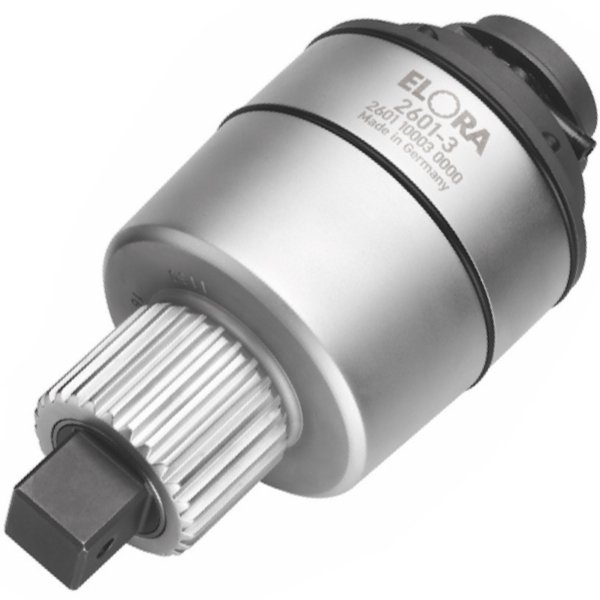 |
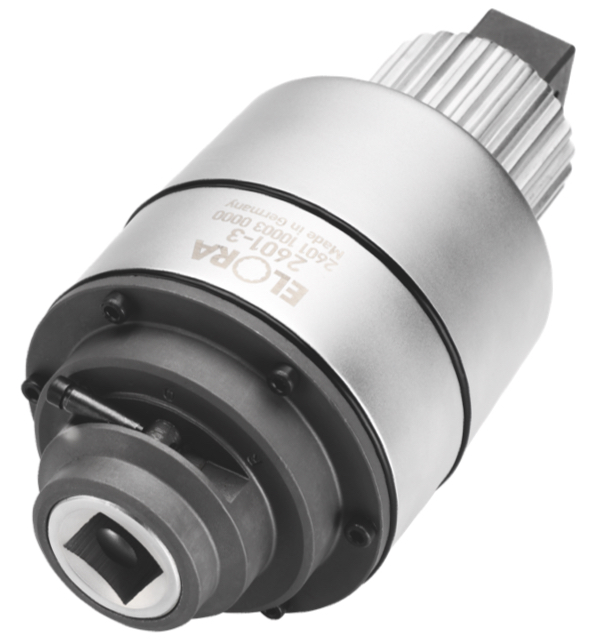 |
The torque ratio varies along with the gear reduction rate, providing a range of settings for different requirements. These tools come with a return stop, are capable of bi-directional actuation, and the precision is tightly controlled, with a high accuracy that maintains a tolerance better than ±5%. The use of these multipliers is exclusively for mechanical actuation, and they are housed in a waterproof case for protection against environmental elements.
ELORA 2601 ‘s Features
The design is compact, reducing the need for excessively long levers and the associated risk of personal injury. Uniform force transmission protects the nuts and bolts from damage, and the construction is both light and sturdy. The tool requires no external power supply and offers long-term accuracy with a low-maintenance build, making it a cost-effective investment.
- Maximum torque up to 10,000 Nm
- Planetary gearing system
- Specially hardened gear wheels
- Permanent internal greasing
- Overload protection with cutout
- Exchangeable drive heads
- Matte chrome-plated/phosphated surfaces
- Bi-directional actuation
- High accuracy with less than ±5% tolerance
- For mechanical actuation only
- Waterproof case
- Compact and durable design
- No external power supply needed
- Long-term accuracy
- Low maintenance
It is especially recommended for use with ELORA torque wrenches and can be supported with a range of accessories available for different applications. The torque multipliers are presented with their weight specifications both with and without the case and brace support, and each model comes in a single piece, emphasizing their ready-to-use design.
What is the difference between “Torque Ratio” and “Gear Reduction”?
The “Torque Ratio” and “Gear Reduction” are terms associated with mechanical systems that utilize gears, but they refer to different aspects of the gearing mechanism.
Torque Ratio
- This is a measure of the multiplication of torque achieved by the tool.
- It is the ratio of the output torque to the input torque.
- A higher torque ratio means that the tool can increase the input torque to a greater output torque, allowing a smaller force to achieve a higher tightening force on a fastener.
Gear Reduction
- Gear reduction refers to the ratio of the speed of the input gear (the gear attached to the input power source) to the speed of the output gear (the gear doing the work).
- It’s a measure of how much the gear system reduces the input speed to produce a slower output speed.
- A high gear reduction means the output gear turns slower than the input gear, which usually results in an increase in torque.
The torque ratio is directly concerned with the increase in torque from the input to the output, while gear reduction focuses on the decrease in speed between the input and the output, which typically results in an increase in torque due to the conservation of power (since power is the product of speed and torque). The two are related; often in systems where there is a gear reduction, there is an increase in torque, which can be described by the torque ratio.
Specifications
ELORA 2601-series torque multipliers, excluding the first and last columns:
| Number | Max. Output Capacity (Nm) |
Max. Input Capacity (Nm) |
Square Drive |
Torque Ratio |
Gear Reduction |
Return Stop |
L/mm |
|---|---|---|---|---|---|---|---|
| 2601-1 | 1500 | 416 | 1/2″ | 13.6 | 4:1 | – | 90 |
| 2601-2 | 1500 | 416 | 3/4″ | 13.6 | 4:1 | x | 137 |
| 2601-3 | 3500 | 269 | 3/4″ | 13.0 | 16:1 | x | 95 |
| 2601-4 | 4500 | 264 | 1 1/2″ | 17.0 | 26:1 | x | 120 |
| 2601-5 | 7000 | 159 | 1 1/2″ | 44.0 | 59:1 | x | 272 |
| 2601-6 | 10000 | 181 | 1 1/2″ | 55.0 | 74:1 | x | 272 |
This table shows each variant’s output and input capacity, the size of the drive square, the torque ratio, the gear reduction ratio, whether it has a return stop, the length in millimeters, and the weight without the case and brace support.
Selecting the Right Torque Wrench for Use with a Manual Torque Multiplier
When pairing a torque wrench with a manual torque multiplier, it’s essential to consider several factors to ensure compatibility and optimal performance. Here is a guide to help you select the appropriate torque wrench for use with a manual torque multiplier:
- Determine the Required Torque Output: Calculate the final torque requirement for the application. This is the torque that the fastener needs.
- Consider the Torque Multiplier Ratio: Look at the torque multiplication factor of the manual torque multiplier you intend to use. This is usually stated in the product specifications.
- Calculate the Torque Wrench Setting: Divide the final required torque by the multiplier’s torque ratio to find out what setting you should use on the torque wrench. For example, if you need 3000 Nm of torque and your multiplier has a torque ratio of 4:1, you’ll set the torque wrench to 750 Nm.
- Check Torque Wrench Capacity: Ensure the torque wrench you select can be set to the calculated value from step 3. It should have a range that includes this setting comfortably within its scale, not at the very end of its range.
- Choose the Drive Size: The drive size of the torque wrench should match the input drive of the torque multiplier. If your multiplier has a 1/2″ input drive, your torque wrench should have a 1/2″ output drive.
- Quality and Calibration: Select a torque wrench from a reputable manufacturer that comes with calibration certification to ensure accuracy. The torque wrench must be calibrated regularly to maintain its precision.
- Consider the Return Stop: If the torque multiplier has a return stop (which prevents it from turning backward), make sure the torque wrench is compatible with this feature.
- Type of Torque Wrench: Choose the type of torque wrench according to the job’s needs. Click-type torque wrenches are common and give a physical indication when the set torque is reached. Electronic torque wrenches may offer more features, like digital readouts.
- Ergonomics and Length: Ensure that the torque wrench is comfortable to hold and use. The length of the wrench will affect the amount of force you need to apply. Longer wrenches can exert more torque with less force.
- Evaluate Additional Features: Some torque wrenches come with features like angle measurement, which can be useful for applications requiring both torque and angle specifications.
Always follow the manufacturer’s instructions for both the torque wrench and the torque multiplier to ensure proper use and safety. Regularly inspect your tools for wear and recalibrate as necessary to maintain accuracy.
| SKU | Add | Momen Nm | Gear ratio |
|---|---|---|---|
| 2601-1 | 1500 | 4:1 | |
| 2601-2 | 1500 | 4:1 | |
| 2601-3 | 3500 | 16:1 | |
| 2601-4 | 4500 | 20:1 | |
| 2601-5 | 7000 | 59:1 | |
| 2601-6 | 10000 | 74:1 |
- Pending orders

